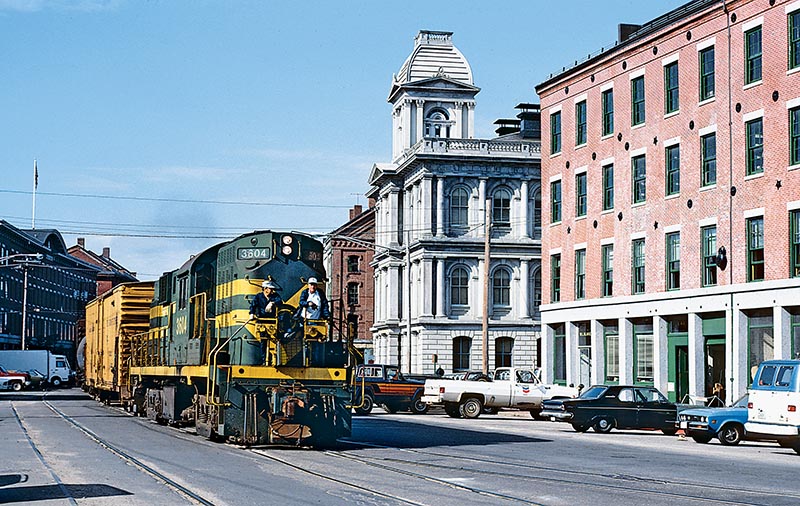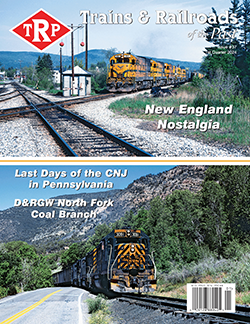 by Gordon Lloyd Jr./photos from the Lloyd Transportation Library
by Gordon Lloyd Jr./photos from the Lloyd Transportation Library
The region collectively known as New England typically encompasses the following states, in alphabetical order: Connecticut, Maine, Massachusetts, New Hampshire, Rhode Island and Vermont, covering almost 74,000 square miles. Boston is easily the largest New England city, with notable history, treasures, and links to the past such as the Boston Tea Party, the city in which the disposable safety razor was invented, the country’s first subway system, the place in which both the telephone and Tupperware were created and of course, the ominous Green Monster. Something called Facebook was conceived there too; you might have heard of it.
From a railroad perspective, the area sparks particular interest too, for, save the region’s largest city, the expanse discussed here was largely devoid of influence from the much larger railroads that operated not far south and west of the city. I can hear the critics raising protest, but north of Boston, the constituency of railroads lack the foremost appellations New York Central, Baltimore & Ohio, Chesapeake & Ohio and Pennsylvania Railroad, which dominated the railroad scene in the eastern United States. Yes, Canadian National, and even Canadian Pacific had influence, but that was obviously a Canadian effect.
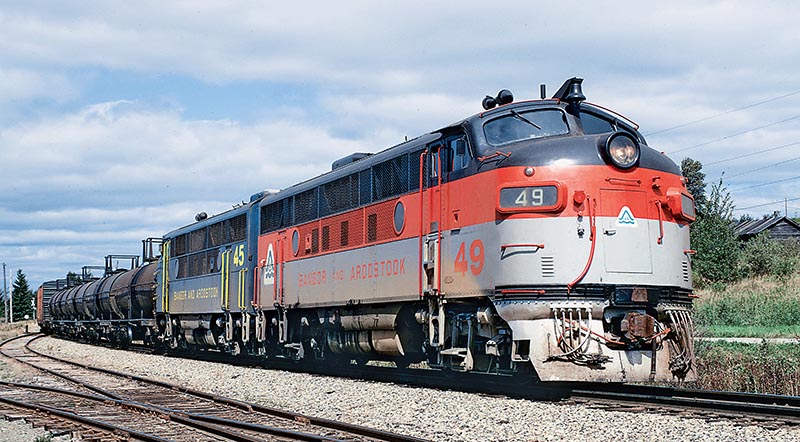
ABOVE: Those who keep close track of locomotive rosters did a double take when BAR #49 appeared in new red, gray and black paint. The new colors, previously displayed on several Geeps, told part of that story. BAR F3A 47 and BL2 53 were damaged in a derailment at Eagle Lake, Maine, in September 1972. Ultimately, the BL2 was retired, but 47 was rebuilt, and as a result, renumbered to 49 as seen here on September 10, 1973. This paint scheme was short-lived — it was later modified with a “V” pattern on the nose with white accent striping between the three colors. —Photo by George W. Turnbull – LTL
The region still had important players. Boston & Maine had significant influence. The railroad dabbled in streamlined speedsters (The Flying Yankee, which initially saw service between Boston and Bangor, Maine, via the Maine Central), experimented with an opposed-piston Talgo trainset (the only Fairbanks-Morse locomotives on the property), operated international passenger service to Canada and embraced the RDC (Budd’s Rail Diesel Car) concept like no other railroad, in an early attempt to stave off the losses of hauling passengers. In fact, Boston & Maine utilized 109 cars (known as “Highliners” on the B&M) in their effort to modernize and reduce fixed costs and was one of the few properties to utilize every RDC option – RDC-1, RDC-2, RDC-3, RDC-4 and the rare RDC-9, a trailer-only version. The Boston & Maine RDC fleet included more than one-quarter of all RDC production!
Boston & Maine operated largely west and north of Boston, extending into the states of New York, New Hampshire, Vermont, and Maine. Boston & Maine controlled the Maine Central from 1933 to 1955 under the Edward French administration. Modernization was the theme during that tenure, building on the improvements the previous Hannauer management.
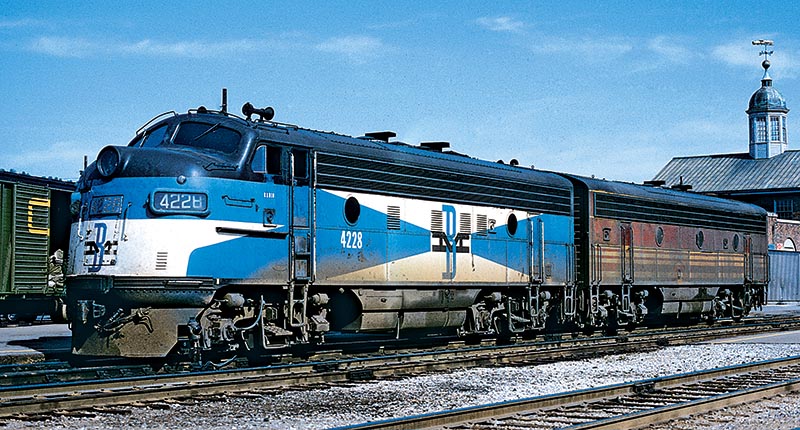
ABOVE: The unique or unusual often draws the interest of adherents. Offered here as evidence, a stunning example of those terms at White River Junction, Vermont, in June 1965. Boston & Maine’s larger fleet of 18 F2A units overshadowed a much smaller group of F3s – only two A’s and two B’s. Further, 4228A, one of those atypical B&M F3A units, wears the eye-catching dress of the McGinnis legacy; F7-style grilles mask her telltale appearance. —Photo by Matthew J. Herson – LTL
As on most U.S. railroads, the war years took a toll on the B&M, and out of necessity, dieselization was undertaken in earnest. Relatively modern steam was shouldered aside with the arrival of 24 FT A&B sets in 1943 and 1944, the result an undeniable and dramatic impact on scheduling and efficiency. Their delivery also permitted the passage of heavy freight trains through the Hoosac Tunnel without aid from the electric helpers. The tunnel electrification operated from 1910 through 1946, its need negated by EMD’s first streamlined freight-hauling diesel-electrics. The success of the FT’s cemented a relationship with EMD, though B&M maintained a modest fleet of ALCO switchers and road-switchers. With the exception of the Talgo trainset, Boston & Maine did not acquire Baldwin or F-M diesels.
The calamitous Patrick McGinnis era arrived in 1956, and the Boston & Maine was included in far-flung plans to create a northeast railroad colossus, as the New Haven was also under that regime’s control. Improvements in that era were devoid of measurable enhancements, the railroad dealing with retrenchment from deficits accountable to passenger trains, industry upheaval and associated traffic losses. Equipment-wise, Boston & Maine’s elderly FT fleet was offered as fodder to make the acquisition of fifty GP9 locomo-tives more affordable and Budd Rail Diesel Cars became ubiquitous across the railroad…
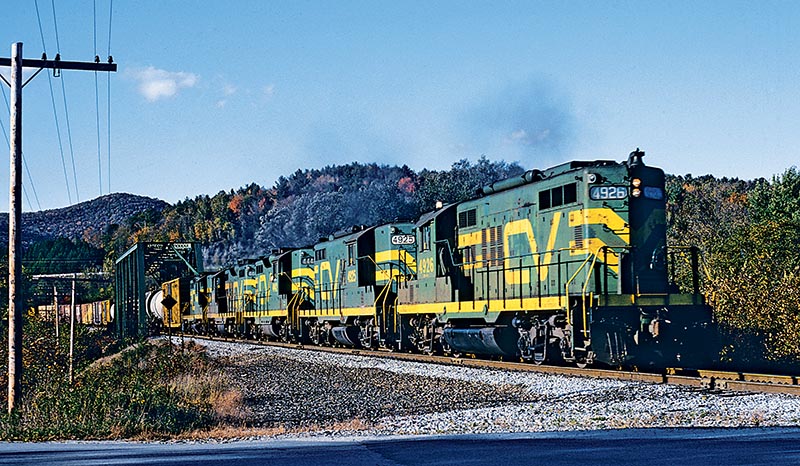
ABOVE: It’s October 1983, but the famous New England leaves have barely begun to “change.” For now, Central Vermont’s dis-tinctive corporate design compliments the spring and summer foliage of Vermont. CV employed the stylized company font of owner Canadian National, yet took liberties with colors and striping for its locomotive fleet to profess individuality. Five of their brood move eastbound freight, all first-generation EMD Geeps. Canadian National sold Central Vermont to RailTex in 1995, becoming New England Central. —Lloyd Transportation Library
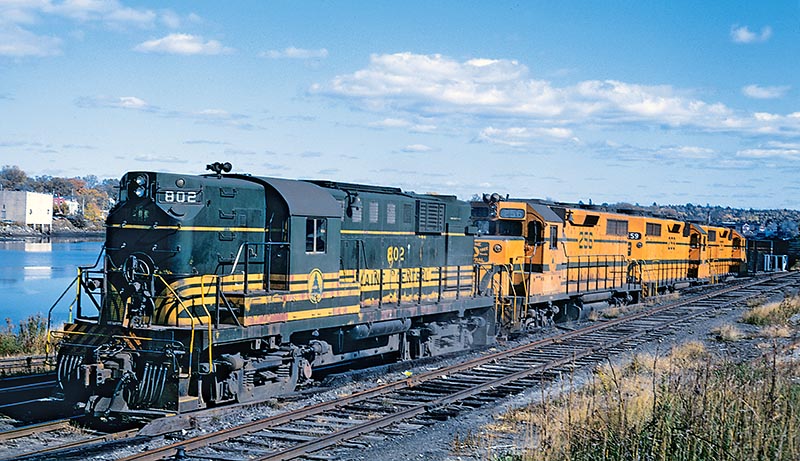
ABOVE: That former Portland RS11 #1082 became Maine Central #802. Still dressed in the paint scheme it wore on the Portland Terminal, the 802 works in Calais, Maine, on October 12, 1975. Transformation to MEC included “Maine Central” lettering on the long hoods (in place of “Portland Terminal”) and the Pine Tree emblem on the cab sides. Though outnumbered by their EMD competition, the RS11 units held their own, working capably with the GP7s, GP38s and late-comer Independence Class U18Bs that were built by General Electric. —Photo by George Horna – LTL


